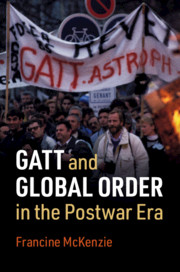Book contents
- GATT and Global Order in the Postwar Era
- GATT and Global Order in the Postwar Era
- Copyright page
- Dedication
- Contents
- Figures
- Tables
- Acknowledgements
- Abbreviations
- Introduction
- 1 Accidental Organization
- 2 ‘An Arrow in the Western World’s Quiver’
- 3 ‘Take It or Leave It’
- 4 ‘Spread Like the Plague’
- 5 ‘Rich-Man’s Club’
- 6 ‘Agricultural Anarchy’
- Conclusion
- References
- Index
3 - ‘Take It or Leave It’
The EEC Challenge to GATT
Published online by Cambridge University Press: 02 May 2020
- GATT and Global Order in the Postwar Era
- GATT and Global Order in the Postwar Era
- Copyright page
- Dedication
- Contents
- Figures
- Tables
- Acknowledgements
- Abbreviations
- Introduction
- 1 Accidental Organization
- 2 ‘An Arrow in the Western World’s Quiver’
- 3 ‘Take It or Leave It’
- 4 ‘Spread Like the Plague’
- 5 ‘Rich-Man’s Club’
- 6 ‘Agricultural Anarchy’
- Conclusion
- References
- Index
Summary
As a powerful member of GATT, the EEC evoked fear and criticism. The EEC, especially France, in turn criticized GATT for ill-serving the interest of Europe and being a tool of the USA. This chapter examines the GATTEEC collision. The EEC tried to limit GATT s authority and proposed regional organizations such as the OECD as alternatives. However, it also supported trade liberalization, in particular during the Kennedy round of GATT talks (1964–1967). The GATT secretariat and many members tried to make the EEC observe GATT norms, rules, and practices, challenging the EEC s support for regional trade agreements and protectionist and discriminatory trade practices. This chapter argues that the EEC was both a constructive and an obstructive force in GATT. It strengthened and threatened the authority of GATT and it promoted and impeded trade liberalization. In its inconsistent support for GATT and liberal trade, the EEC was no different from other members. Because the USA supported European integration, other members stepped up to defend GATT rules and practices, revealing both the need and the opportunities for smaller countries to assume leadership positions.
Keywords
- Type
- Chapter
- Information
- GATT and Global Order in the Postwar Era , pp. 104 - 140Publisher: Cambridge University PressPrint publication year: 2020

